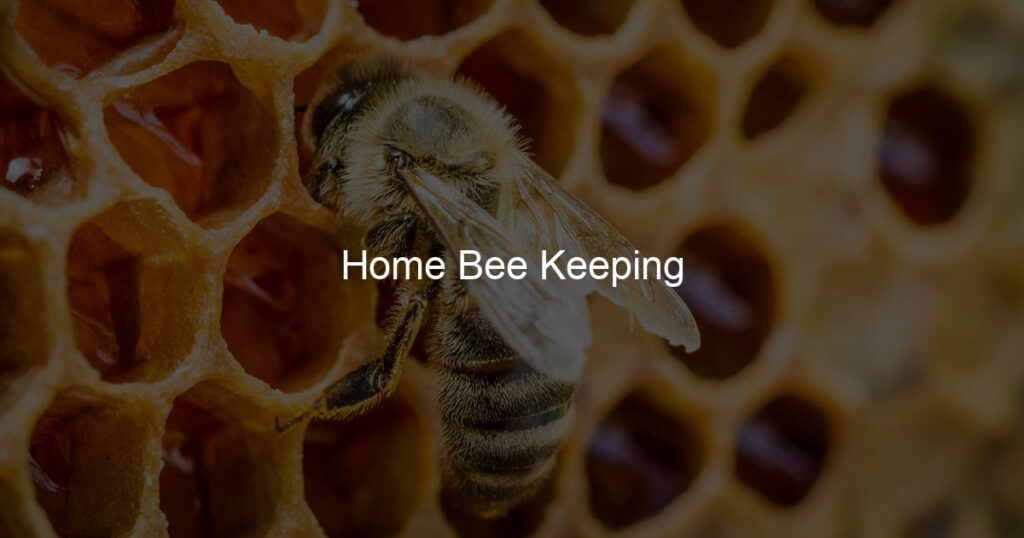Did you know that you can keep bees in your own backyard? Home beekeeping is a great way to get started in the world of beekeeping, and it’s a lot easier than you might think.
Here are some tips to get you started on your journey to becoming a home beekeeper.
What are the easiest bees to keep?
If you are looking to own a bee colony but don’t know where to start, the answer is probably stingless bees. They are hardy and require less maintenance than traditional honey bees, making them an ideal species for amateur beekeepers.
Stingless bees don’t form swarms and usually won’t sting humans unless provoked, and they have a naturally low susceptibility to pain so even if stung it’s unlikely to hurt much.
Most varieties get their nectar from regional sources and require little supplemental feeding, whereas honey bees need regular supplementation with sugar water or other supplements during months without natural forage sources.
However, stingless bees tend to smaller yield compared to their traditional counterparts, so if you’re aiming for maximum honey production then these might not be the right choice for you.
What is the best bee house for beginners?
For those just starting in beekeeping, the best bee house for beginners is one that provides an easy-to-access design, offers protection from predators and the elements, and is also conveniently placed.
While there are many different types of bee houses available on the market, a popular option for novice beekeepers is a mason jar-style shelter with a slanted roof. This type of housing gives bees plenty of space to establish their hive while keeping them safe from predators and severe weather.
In addition, its placement should be convenient for both the beekeeper and the bees; ideally somewhere near lots of flowers, away from strong winds or direct sunlight. With this type of shelter and a bit of patience, new beekeepers are sure to get off to a great start in taking care of their hives!
What are the basics of a beehive?
The basics of a beehive are surprisingly complex: honeybees have coexisted with humans since ancient times, but we are still learning the minutiae of their remarkable societies.
A typical beehive is composed of wax combs, which an entire colony produces collaboratively to form chambers within the hive that provide places for the queen bee to lay her eggs, larvae to develop and mature, and honey to be stored for sustenance during cold months.
Bees also use these cells for various forms of communication, including powerful pheromones that help orient and guide hive inhabitants. While there is much more to say about the fascinating architecture of beehives, understanding these particular basics presents one with a greater appreciation for our tiny natural collaborators.
How do I attract bees to my new bee house?
Adding a bee house to your backyard is an excellent way to give bees a safe place to nest while also giving you the chance to observe and appreciate them.
To ensure that your bee house gets visits from bees, it’s important to create an ideal habitat for them. Make sure that the bee house is placed in a sunny spot and about four-to-five feet off the ground, and fill it with natural materials such as dried leaves, stemmed flowers, and mud.
Additionally, reducing the use of pesticides in your garden will allow for more bee-friendly plants like lavender and mint. Offering food sources like bowls of sugar water can provide additional incentives for the bees to frequent their new home. With just a few simple steps, you’ll be on your way to creating mason bee nesting sites that will provide shelter and boost pollination in your area.
Do bees recognize their owners?
Many beekeepers express the sentiment that their bees recognize them and are less likely to sting when they do their regular maintenance.
Recent studies conducted involving the use of “smiley face” masks shown to beehives seem to suggest otherwise; bees seemed to be relatively unaffected by facial recognition, as they were just as likely to sting the person wearing a mask with a friendly expression as they were with an angry face.
This suggests that, while there may be an element of habituation in some hives which leads to more docile behavior from the bees towards their owner, it is not due to facial recognition.
Furthermore, this habituation should not be confused with emotional attachment – rather, the bees have become accustomed to the presence of their keeper and factor it into their risk/reward assessment before deciding whether or not they wish to sting.
Final Thoughts
All in all, beekeeping is an incredibly rewarding hobby that may take a little dedication, hard work, and knowledge but the results are well worth it. Through home beekeeping, families can enjoy watching the natural beauty of honeybee life and the fascinating process of making their honey.
With your bees, you’ll have access to raw stockpiles which you can use to craft tasty treats like honeycomb candy or lip balm that you can give to family and friends. Plus, with your apiary at home, you’ll be able to better appreciate pollination happening right around you and realize your part in the larger ecosystem.
Beekeeping is a wonderful way to help the environment by increasing much-needed pollinators and educating yourself on some unique creatures while getting endless entertainment in the process.
Although a considerable undertaking in most cases, they become a part of our lives once they enter our environment. So research thoroughly before making any investments, limit expectations yet remain open-minded – this journey has so much to offer!








